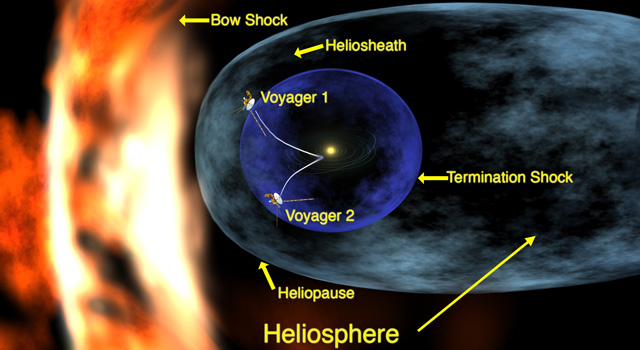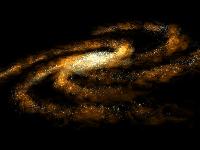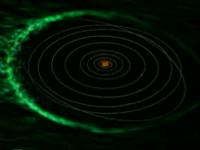News | May 24, 2005
Voyager enters Solar System's Final Frontier

NASA's Voyager 1 spacecraft has entered the solar system's final frontier, a vast, turbulent expanse where the Sun's influence ends and the solar wind crashes into the thin gas between stars.

"Voyager has entered the final lap on its race to the edge of interstellar space, as it begins exploring the solar system's final frontier," said Dr. Edward Stone, Voyager project scientist at the California Institute of Technology in Pasadena. Caltech manages NASA's Jet Propulsion Laboratory in Pasadena, which built and operates Voyager 1 and its twin, Voyager 2.
In November 2003, the Voyager team announced it was seeing events unlike any encountered before in the mission's then 26-year history. The team believed the unusual events indicated Voyager 1 was approaching a strange region of space, likely the beginning of this new frontier called the termination shock region. There was controversy at that time over whether Voyager 1 had indeed encountered the termination shock or was just getting close.
"The consensus of the team now is that Voyager 1, at 8.7 billion miles from the Sun, has at last entered the heliosheath, the region beyond the termination shock," said Dr. John Richardson from MIT, Principal Investigator of the Voyager plasma science investigation.
The termination shock is where the solar wind, a thin stream of electrically charged gas blowing continuously outward from the Sun, is slowed by pressure from gas between the stars. At the termination shock, the solar wind slows abruptly from its average speed of 300 to 700 km per second (700,000 - 1,500,000 miles per hour) and becomes denser and hotter.

The strongest evidence that Voyager 1 has passed through the termination shock into the slower, denser wind beyond is its measurement of an increase in the strength of the magnetic field carried by the solar wind and the inferred decrease in its speed. Physically, this must happen whenever the solar wind slows down, as it does at the termination shock. Consider a highway with moderate traffic. If something makes the drivers slow down, say a puddle of water, the cars pile up - their density increases. In the same way, the density (intensity) of the magnetic field carried by the solar wind will increase if the solar wind slows down. In December 2004, Voyager 1 observed the magnetic field strength increasing by a factor of two and a half, as expected when the solar wind slows down. The magnetic field has remained at these high levels from December until now. An increase in the magnetic field intensity of about 1.7 times was seen at the time of the event announced in 2003.
"Voyager's observations over the past few years show that the termination shock is far more complicated than anyone thought," said Dr. Eric Christian, Discipline Scientist for the Sun-Solar System Connection research program at NASA Headquarters, Washington, DC.
For their original missions to Jupiter and Saturn, the Voyagers were destined for regions of space far from the Sun, so each was equipped with three radioisotope thermoelectric generators to produce electrical power for the spacecraft systems and instruments. Still operating in remote, cold and dark conditions 27 years later, the Voyagers could last until 2020.
More Voyager Resources
Video: Voyager Spacecraft Animation
Sound of Solar Wind
Learn More About Where Voyager Is
Solar Blast Blows Past Voyager
What Does the Edge of the Solar System Look Like?
JPL Voyager Home Page
Voyager's Golden Record
The History & Science of Voyager
Written by: Jane Platt (Jet Propulsion Laboratory), Dolores Beasley (NASA HQ), and Bill Steigerwald (NASA Goddard Space Flight Center)
NEWS RELEASE: 2005-084
